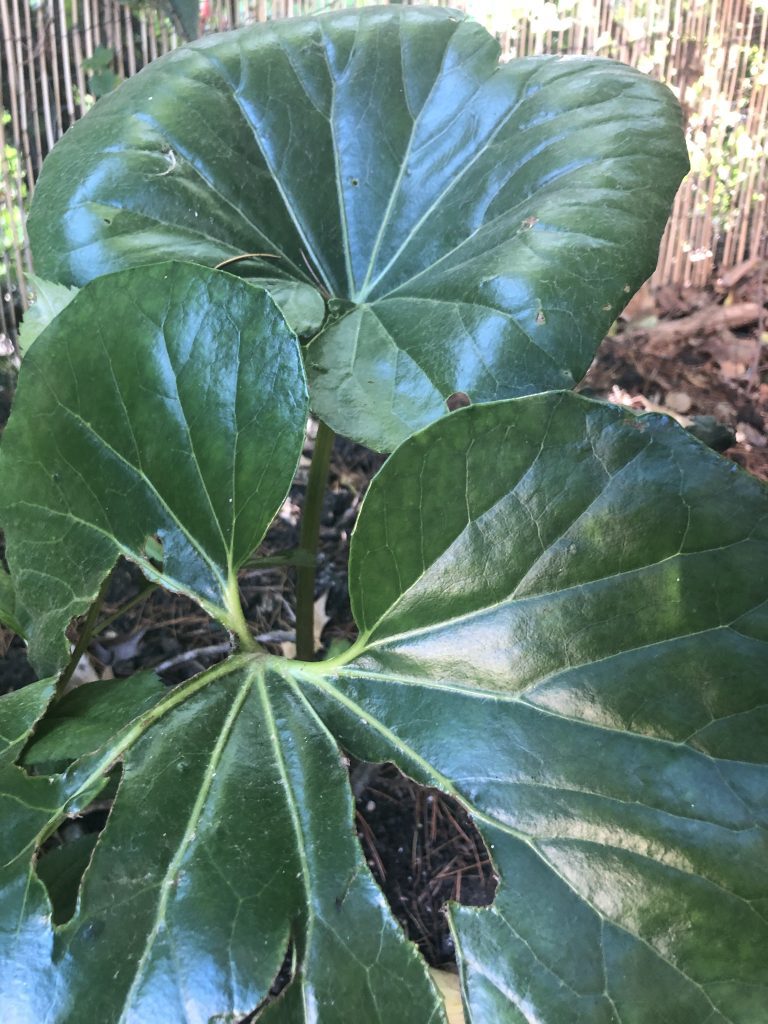Farfugium Japonicum is a very useful plant for ground cover. Its massive leaves, up to 30cm across, look wonderful beneath towering tree ferns or palms. It can also look great as a specimen plant in its own right.
Farfugium Japonicum is flexible on position as well, being capable of coping with partial shade and full sun. it prefers partial sun.
Growing Farfugium in the UK: A Comprehensive Guide
Farfugium, commonly known as leopard plant or Ligularia, is a striking perennial known for its lush, ornamental foliage and bright yellow flowers. Native to the moist, shaded forests of East Asia, this plant has found a place in many UK gardens, particularly for those looking to add a touch of exotic greenery. Here’s a detailed guide to growing Farfugium in the UK.
Ideal Growing Conditions
Climate: Farfugium thrives in the mild, temperate climate of the UK. It prefers cool to moderate temperatures, making it well-suited to British gardens. It is hardy in USDA zones 7-10, which covers most of the UK.
Light: Farfugium grows best in partial to full shade. While it can tolerate some morning sun, too much direct sunlight, especially during midday, can scorch its leaves. A dappled shade beneath trees or a north-facing border is ideal.
Soil: The plant prefers rich, well-draining soil. It thrives in soil that is consistently moist but not waterlogged. Adding organic matter like compost can improve soil structure and fertility, providing the nutrients needed for robust growth.
Watering: Regular watering is crucial, especially during dry spells. Farfugium prefers consistently moist soil. Mulching around the base can help retain moisture and keep the roots cool.
Planting and Maintenance
Planting Time: The best time to plant Farfugium is in spring or early autumn. This allows the plant to establish its roots before the more extreme temperatures of summer or winter.
Spacing: When planting, space the plants about 18-24 inches apart to allow for their mature size. Farfugium can spread up to 3 feet, so give them enough room to grow.
Fertilizing: Feed the plant with a balanced, slow-release fertilizer in spring. This promotes healthy growth and vibrant foliage. Avoid high-nitrogen fertilizers as they can lead to excessive leaf growth at the expense of flowers.
Pruning: Remove dead or damaged leaves regularly to keep the plant looking tidy. After flowering, you can cut back the flower stalks to encourage more foliage growth.
Common Varieties
- Farfugium japonicum ‘Aureomaculatum’: Known for its glossy green leaves with yellow spots, this variety adds a splash of color to shady areas.
- Farfugium japonicum ‘Giganteum’: Features large, rounded leaves that can grow up to a foot across, making it a dramatic focal point in the garden.
- Farfugium japonicum ‘Crispata’: This variety has ruffled, crinkled leaves that add interesting texture to the garden.
Pests and Diseases
Farfugium is relatively pest-resistant but can occasionally suffer from:
- Slugs and Snails: These pests are attracted to the lush foliage. Using slug pellets or barriers can help protect young plants.
- Aphids: These can be controlled with insecticidal soap or by encouraging natural predators like ladybirds.
- Leaf Spot: A fungal disease that can cause brown spots on leaves. Improving air circulation and avoiding overhead watering can reduce the risk.
Winter Care
In the UK, where winters can be cold and wet, providing some winter protection can be beneficial:
- Mulching: Apply a thick layer of mulch around the base of the plant to protect the roots from freezing temperatures.
- Frost Protection: In areas prone to frost, cover the plant with fleece or move potted specimens to a sheltered location.
Propagation
Farfugium can be propagated through division or seed:
- Division: The easiest and most common method. In spring or autumn, dig up the plant and carefully divide the root clump into smaller sections, each with several shoots. Replant the divisions at the same depth they were growing before.
- Seed: Farfugium can be grown from seed, although this method is slower. Sow seeds in a seed tray filled with moist compost and cover lightly. Keep the tray in a warm, shaded area until germination, then transplant seedlings when they are large enough to handle.
Landscaping Uses
Farfugium is highly versatile and can be used in various garden settings:
- Shade Gardens: Its tolerance for low light makes it perfect for shaded areas under trees or along north-facing walls.
- Water Gardens: Ideal for planting near ponds or streams where the soil remains moist.
- Container Gardening: Grows well in large containers, which can be moved to ideal locations depending on the season.
Conclusion
Growing Farfugium in the UK can add a unique and exotic touch to your garden with its bold foliage and cheerful flowers. By providing the right conditions and care, gardeners can enjoy the beauty of this plant year-round. Whether used as a focal point in a shaded border or to add interest to a water garden, Farfugium is a versatile and rewarding choice for UK gardeners.

With regards to hardiness, the plant is evergreen if the temperature does not fall below -5C. below this and it loses its leaves but can survive down to -12C. The leaves will re grow in the spring.
Farfugium Japonicum likes moist conditions and is suited to woodland, bog garden, or pond side locations. Over winter it likes a lot of mulch as a covering.

